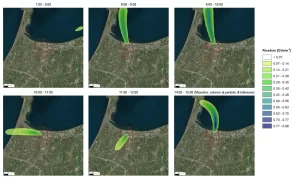Odor modelling evaluation
TerrAria deals with the odorigenic impact assessment through a modeling approach, such as using the CALPUFF model to assess local-scale effects. Odorigenic substances emitted by anthropogenic activities can severely limit land use. Therefore, associating atmospheric pollutant emissions with limits that characterize their odorigenic impact, in addition to concentration limits, arises from the need to ensure that activities with significant osmogenic flows do not hinder land use consistent with the provisions of adopted urban planning.
At the national level, Legislative Decree 183/2017 (implementing Directive 2015/2193) introduced in Part Five of Legislative Decree 152/2006 (Consolidated Environmental Act) Article 272-bis on odorigenic emissions, which allows the Regions and Competent Authorities, when authorizing a plant, to provide specifically defined prevention and limitation measures for odorigenic emissions, which may consist of:
- emission limit values expressed in concentration (mg/Nm³) for odoriferous substances;
- specific maximum flow rates or maximum odorous emission concentrations expressed in odorimetric units (OUe/s or OUe/m³) for the odorous emission sources of the establishment;
- requirements for facilities with potential odorous impact, including the obligation to implement containment plans, or definition of localization criteria depending on the presence of sensitive receptors around establishments.
The regulations also imply that exceeding the limits specified in the permit will result in penalties (specifically, a fine of up to 10,000 euros or imprisonment of up to one year).
Odor impact is generally measured from the odor concentration expressed in odorimetric or olfactometric units (OU) at m3 , which represent the number of dilutions necessary for 50 percent of the examiners to no longer smell the analyzed sample (UNI EN 13725:2004). At both national and EU level, there is currently no specific legislation in the area of odor nuisance; however, some European countries (Holland, Germany, England) as well as some Italian regions (Lombardy, Piedmont, Apulia…) have defined reference values that represent guidelines for environmental impact assessments. The main normative references are therefore the UNI standards and in particular:
- UNI EN 13725:2004 “Air quality. Determination of odor concentration by dynamic olfactometry.”
- UNI 10796:2000 “Evaluation of atmospheric dispersion of aeriform effluents. Guidance on selection criteria for mathematical models.”
- UNI 10964:2001 “Environmental impact studies. Guide to the selection of mathematical models for air quality impact prediction.”
REFERENCE LIMITS
The Guidelines of Regione Lombardia (Deliberazione Giunta di Regione Lombardia Deliberation of the Lombardy Region Council of February 15, 2012 – n. IX/3018, General Determinations regarding the characterization of gaseous emissions into the atmosphere from activities with high odorigenic impact) define the hourly peak odor concentration values at the 98th percentile on an annual basis at which the population perceives odor. These values are:
- -1 OUe/m3, 50% of the population can smell;
- -3 OUe/m3, 85% of the population perceives odor;
- -5 OUe/m3, 90-95% of the population perceives the odor.
The 98th percentile on an annual basis means the 175th value of the annual series of hourly concentrations rearranged in descending order, which is equivalent to 2 percent of the hours in the year. Therefore, the relevant regulations allow these limits to be exceeded for 175 hours in a year. A frequency of 175 hours in a year corresponds to just over 7 days, or about 3 hours and 20 minutes per week, or just under 15 hours per month.
The Lombardy Region Guidelines on odors specify using a coefficient of 2,3 (peak-to-mean) to obtain hourly peak concentrations from hourly average concentrations.

